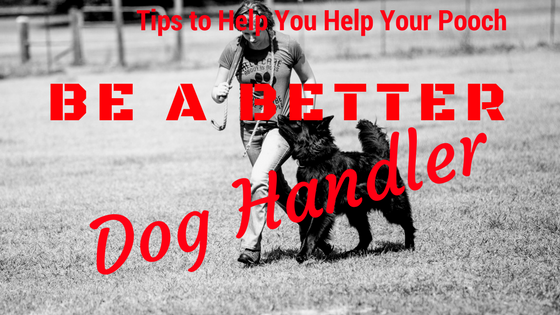Be a Better Dog Handler
Be a Better Dog Handler
Tips to Help You Help Your Pooch
This is an except from my dog training book. If you like it, please share so I can get it published! Thanks guys- you all are fantastic fur parents!
 Becoming a good handler is one of the most important skills you will learn for your dog. With the advent of the Cesar Milan phenomenon, people are more receptive to the idea that it is more teaching the people than it is teaching the dog. When I teach private lessons, it is a little about teaching the dog, but it is mostly about teaching you how to teach your dog. While many of my clients like the idea that I will be around forever (I am skeptical about this notion) it is not necessarily feasible. You have to be your dog’s mentor. When I explain it in lessons, it seems fairly simple. Until we put it into practice. Then leashes get tangled and treats fly unintentionally like beads rain at a Mardi Gras parade. People get so caught up thinking about what they are doing (because it is about how they are teaching their dogs right?) that they stop becoming effective teachers. Talk about an ouroboros effect!
Becoming a good handler is one of the most important skills you will learn for your dog. With the advent of the Cesar Milan phenomenon, people are more receptive to the idea that it is more teaching the people than it is teaching the dog. When I teach private lessons, it is a little about teaching the dog, but it is mostly about teaching you how to teach your dog. While many of my clients like the idea that I will be around forever (I am skeptical about this notion) it is not necessarily feasible. You have to be your dog’s mentor. When I explain it in lessons, it seems fairly simple. Until we put it into practice. Then leashes get tangled and treats fly unintentionally like beads rain at a Mardi Gras parade. People get so caught up thinking about what they are doing (because it is about how they are teaching their dogs right?) that they stop becoming effective teachers. Talk about an ouroboros effect!Here are a few simple tips when working on perfecting your dog handling skills:
1. BE STILL. This does not mean be a statue and do not move. It means quiet your extraneous movements. Stop bumbling around with your pockets. Have your treats ready (by ready I mean the hand to dog munch time is less than a second). Stop fidgeting with the leash. It is only there as a safety. You are teaching your dog to put himself where you need to be, not lead him around like a horse. The leash is not that important. Only make movements that pertain to what you are explaining to your dog. Stop scratching, pacing, waving your hands etc. Quiet your mind. Doubts racing around in your mind go straight down the leash to your dog. Your dog will stop worrying about learning what you want him to learn and start worrying about what you are worrying about (the dog has no clue what you are worrying about. It would never occur to him that you are worrying about failing him). He just knows you’re worried or frustrated or distracted or feeling defeatist.
2. BE POSITIVE. Envision your dog doing exactly as you say. While some positive realization mantras seem like a bit of malarkey to me, in this instance, it is magic not malarkey. Your dog is exponentially more likely to do what you want if you think he will and envision it so… unless what you want is for your dog to make you a pot of coffee. I keep trying that one, but so far my jerk dog just sits in the kitchen next to it and expects a cookie.
3. BE PATIENT. Everyone says working with dogs requires patience. It is no fallacy. It takes your dog a bit longer to piece through a new command than it would for you. Wait and see if she gets it on her own. It is better for her to reason through a new puzzle (command) on her own than for you to interrupt her thinking process and manually smoosh her into position. The thinking process is crucial for her understanding of a command. Do not rush it. Again, simply be still. If she gets up and wanders off, then re-attack, but if she is pacing in front of you, sitting looking away (most people think this is the dog giving up, but it might be this is your dog’s thinking posture- like The Thinking Man only for dogs), or trying different behaviors, let her ponder and experiment. It costs you nothing to give your dog this time, and you have everything to gain.
4. ENUNCIATE. Be very clear, loud, and slow when you use your words with your dog. It is ok to say everything under the planet is a happy, high pitched voice when you are praising. But when you are teaching, limit your words. It is natural for new handlers to want to encourage their dogs while their dogs are in Step 2 The Experimentation Stage of learning a new command (yes you learned that in a previous chapter). Refrain from doing this. While your intentions might be to encourage your dog, you are just distracting him from the problem bumping around in the cogs in his brain.
5. BE AN ACTOR. I should say, be a good enough actor that you can fool your dog. Dogs are no slouches at reading you, so you must be a consummate actor(ess). This goes along with elocution. Exaggerate your necessary movements and do not distract with unnecessary ones. Be prepared to be very excited and very angrily invested in really odd things- such as your dog peeing outside (YAY!) or your dog trying to snatch that piece of doggy jerky during the Leave It exercise (GRRRRR you feel intense ownership of that doggy jerky...no really).
 |
| What a cute doggy? |
Story Time: While working on the research study for my doctoral dissertation, I was privileged to be able to interview several police K-9 handlers with decades of experience. While collecting and documenting their wisdom, one told me a fabulous story about learning to be a dog handler. Officer S told me that when she went through K-9 handler school, they did not pair them immediately with a dog. They had to earn the right to work with a canine and the way they earned that right is by learning handling skills. How did they learn and demonstrate this crucial skill? By tying a leash to a metal ammo can. That’s right. Those archaic, green metal military style ammo boxes. They each were given an ammo can. They had to pet their ammo can, encourage their ammo can, correct their ammo can, teach their ammo can…. walk and potty their ammo can? They had to become excellent enough actors that anyone would believe this ammo can was a real dog…and not just a real dog, but a competent working dog. Only when they had finely honed their ammo can handling skills could they graduate to an actual canine. I laughed so hard when Officer S told me this story, and resolved to start making my clients drag around ammo cans on leashes.
I don't actually make my clients drag around ammo cans, but I do tell them that story to demonstrate the power of play acting for your dog. But I could at any time decide to put this into effect, so sharpen those stage skills, my friends!
Cheers,
Sammy the Dog Trainer









Comments
Post a Comment